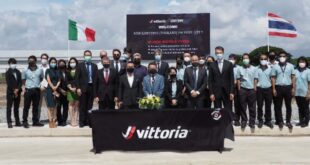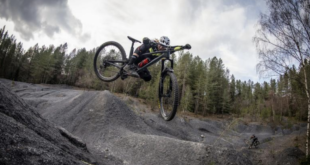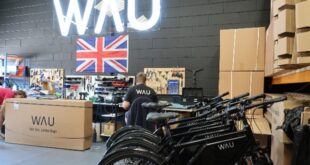In the 1970s the Taiwan Giants were the world’s most successful baseball team, beating American teams at their own game. The Taiwanese government of the time took baseball seriously, seeing it as a sport that Taiwan could excel at, could bloody China’s nose with. When a 36 year-old engineer created his bicycle factory he called it Giant as a homage to this national sporting success. King Liu started Giant in 1972 as a departure from his previous business: a typhoon had wiped out his eel-breeding farm. Making just 3,700 bicycle in its first year, Giant was tiny, but with big plans.
Perhaps King Liu’s shrewdest move was to bring on board Tony Lo. This was in 1973. Lo was a business graduate from the National Taiwan University and had been working as a marketing manager for a trade association. It was Lo who turned a factory making bikes for others into a brand in its own right. This was highly unusual for a Taiwanese company in the 1980s. “It’s still unusual now,” Lo tells me, as he looks out over the flat fields that surround the Giant factory in Taichung.
“We were very early with our own brand. We had lots of ideas how to make bicycles better but our customers were not interested. This was very frustrating. They were only interested in delivery and price, not ideas on how to improve things or how to have a long-commitment. We were eager to talk directly to the consumer with an own-brand, not just talk numbers of bicycles sold. We had a long-term view, not short-term.
“We also wanted to control our own destiny, not always at the mercy of people who said ‘you can have our business but you are one dollar too expensive’.”
The first Giant factory was sited ten kilometres away from the present one. This has grown like topsy but is still not large enough to make the 5.7 million bikes which Giant now produces each year. Giant is the world’s biggest manufacturer of high-end bikes. The Taichung factory produces bikes for Trek, Canyon, Scott, Colnago and Yeti, and bikes from these competing brands can be seen on the same production lines.
For Lo, making bicycles isn’t a commodity business. He’s a cyclist, King Liu is a cyclist (a late convert, mind, he only started in 2008) and Giant executives from around the world are expected to join the bicycle cult, too.
Cult is underselling it. Lo likens cycling to a religion, with bike shops as churches. And he wants to help bike shops in their job of spreading the good word.
He believes independent bicycle dealers will be best equipped to sell cycling if they concentrate on fewer brands (perhaps even just one brand):
“If a bike shop only has 300sq m, it can only display 100 bikes. With two brands in store it can only display 50 bikes each brand. If the shop has three brands, the dilution continues. Less is more. Going multi-brand happened because bike brands went bankrupt often and bike shops wanted to spread their risk. I think with Giant this need not be a worry any more. 40 or 50 years ago, most British bike shops were Raleigh dealers; there were many Gitane dealers in France, and in America most independent dealers sold Schwinn. But these dominant brands didn’t do a good job, didn’t do enough to add value, or improve for their network of dealers. All these brands had problems. Independent dealers had to find ways to survive so went multi-brand. This needs to change, the business model has changed again. We don’t want to own everything, but we do want to help our retailers, help them to find the right bikes for their customers.”
Giant can survive regional dips. “Globally, so far this year we’re doing fine,” said Lo. “Europe overall is not doing too well but the UK is one of the exceptions. We are seeing very good growth over in the UK. Ian [Beasant] and his team have done a good job there. We have good retailers and we give them a lot of good product to stock.”
Good product is available on the continent, too, but trading conditions are tougher, said Lo.
“Elsewhere in Europe it hasn’t been so good. The instability of the Euro has made people in Europe more conservative, they are not buying as many bicycles. In the US it’s fine. It’s been a good year in America.”
And the future looks good for bicycles, according to Lo.
“Obesity is becoming a problem everywhere. Bicycles are good for health. We see growth continuing.”
1972: Giant factory is founded by King Liu. 3,700 frames made in first year.
1973: Tony Lo joins Giant.
1977: Giant secures a manufacturing order from the-then mighty Schwinn of
the USA.
1981: An OEM is turned into an OBM (Original Brand Manufacturer) and Giant is launched as a brand in its own right, a very unusual move for a Taiwanese company of the time.
1986: Makes 1m bikes. Opens base in
the Netherlands.
1987: Releases Cadex 980 C, constructed with carbon-fibre frame tubing and aluminium lugs, a pioneer carbon bike for the mass market.
1992: Opens first factory in China.
1995: Compact Road design created by Giant consultant Mike Burrows
of Norwich.
2003: Release of the TCR composite frame; Giant co-founds the A-team, a collaborative collection of 19 Taiwanese bicycle and parts manufacturers.
2007: Global sales surpass 5m bicycles and $820m in global revenues.
2011: 5.7 million bikes produced; 3m own-brand and the rest for other companies.
2012: Giant celebrates 40 years in the business of making bicycles; now has 11,275 dealers worldwide, including 2,000 Giant-only stores in China.
 BikeBiz Bicycle and cycling retail news
BikeBiz Bicycle and cycling retail news



